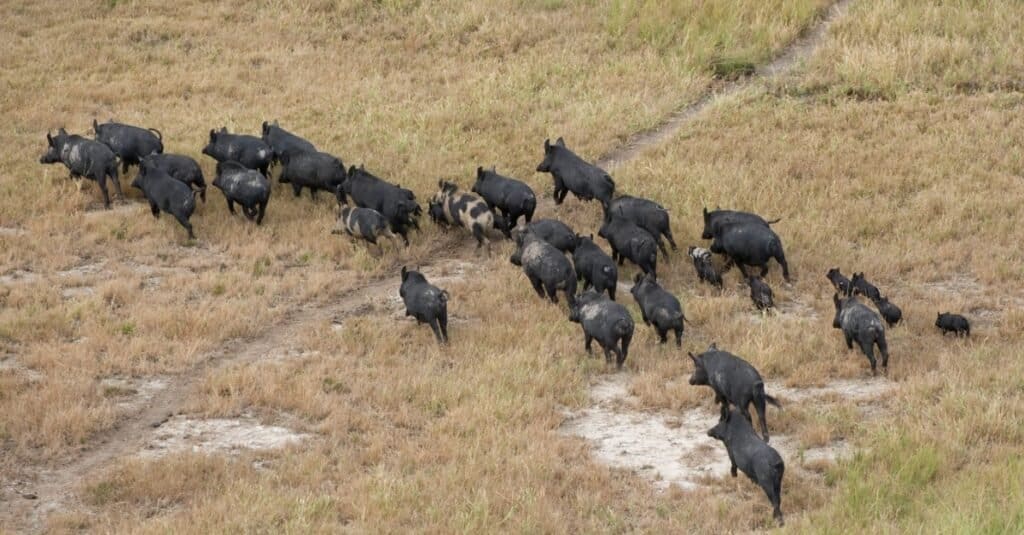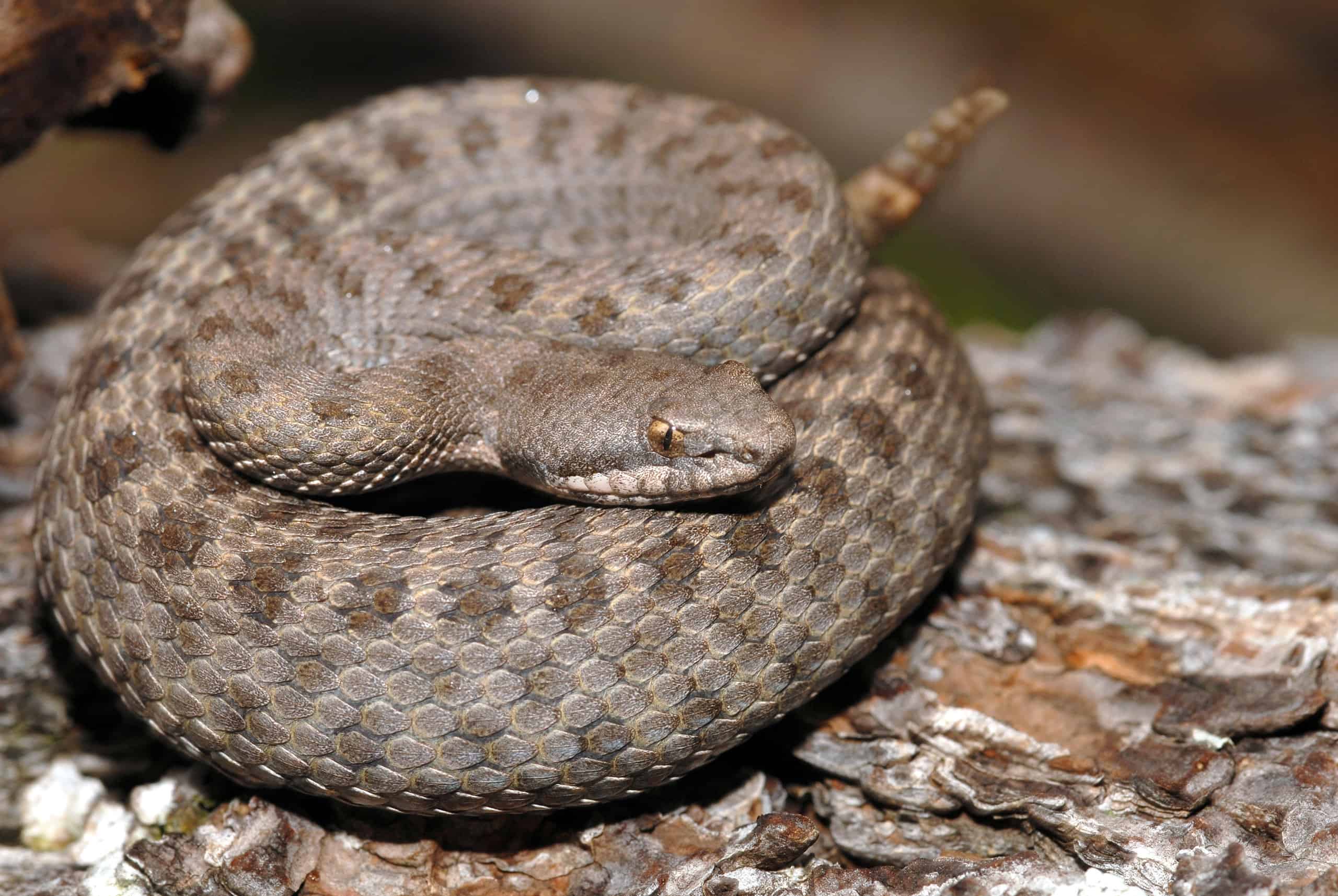Feral hogs and rattlesnakes – if you’re not an animal connoisseur, so to speak, then you probably think that these two animals could never meet and fight. However, three strains of wild hogs (including the feral fog) can be found in Texas, as well as nine types of rattlesnakes (including the most dangerous of them all, the western diamondback rattlesnake).
As a result, the rattlesnake vs. feral hog scenario doesn’t seem impossible at all.
Now that we’ve confirmed that the above could indeed happen, the question that must be answered is who would win – the feral hog or the rattlesnake? If you want to find out, stick around, as we’ll tell you everything about this topic!
What Is a Rattlesnake?

Rattlesnakes are famous for the rattling noise they produce with the help of the
rattleat the end of their tail.
©Creeping Things/Shutterstock.com
Rattlesnakes are part of the Crotalinae subfamily of pit vipers, pit adders, and pit crotaline snakes. Two genera include all the species of rattlesnakes – Crotalus and Sistrurus. These snakes are famously known for the rattling noise they produce with the help of the rattle that can be found at the end of each specimen’s tail.
As a predator, the rattlesnake will use its rattle only when trying to keep predators at bay but also as a warning shot for anything or anyone around. Even though rattlesnakes rarely bite unprovoked, they are still the cause of most snake bite injuries throughout North America.
What Makes a Rattlesnake Dangerous?
The hemotoxic venom is what makes rattlesnakes dangerous, as it destroys the tissue and causes coagulopathy (disrupts blood clotting) and necrosis. A couple of species are equipped with presynaptic neurotoxic venom, known to cause severe paralysis.
According to statistics, death caused by rattlesnake venom typically occurs about six to 48 hours after the bite. Antivenom administered in the first two hours after the bite has a success chance of over 99%.
Regarding feral hogs, venom is still the most dangerous aspect of a rattlesnake.
What Is a Feral Hog?

Feral hogs are common in Australia and the Americas.
©iStock.com/JohnCarnemolla
A feral hog is a formerly domestic pig that has gone feral, which means it now lives in the wild. Feral hogs are common in Australia and the Americas; three strains of wild hogs are present in Texas – the feral hog, the Eurasian hog, and hybrids of the two species.
Domestic pigs usually turn into feral hogs after being released into the wild or escaping their enclosure. It is worth noting that, according to most zoologists, animals that were initially wild, have been captured, and then escaped into the wild cannot be called feral. More specifically, a wild boar is not a feral boar; it’s simply wild – in contrast, a domestic pig that lives in the wild and adopts a wild lifestyle can be considered feralized.
What Makes a Feral Hog Dangerous?
Feral hogs are known to be highly aggressive animals. On top of that, they also carry diseases (hepatitis, salmonella, influenza) that they can easily pass via a bite to humans and potentially other animals. These animals have been involved in attacks on hunters and hikers and even in collisions with aircraft and land vehicles.
A study covering the 2000-2012 period shows that the world’s Northern Hemisphere experienced most wild boar attacks (this includes attacks by feral hogs as well), with roughly 15% of them involving fatalities. In the Northern Hemisphere, the United States had the most attacks.
Regarding the interaction with rattlesnakes (and this is quite big!), all pigs (including wild boars and feral hogs) are immune to snake venom!
Who Emerges Victorious in a Rattlesnake vs. Feral Hog Battle?

A rattlesnake’s venom is useless against an adult feral hog.
©iStock.com/adogslifephoto
Domestic pigs (thus feral hogs included) feature a genetic mutation that affects their cell receptors and prevents the neurotoxin from binding to them. As a result, rattlesnake venom (and snake venom overall) is useless against an adult feral hog (piglets are still vulnerable, and they’re also more likely to be targeted by rattlesnakes).
Besides pigs, hedgehogs, honey badgers, and mongooses are the other animals immune to snake venom. They are likely the only species that can encounter a rattlesnake, fight it, get bitten, potentially kill the snake, and then live to tell the story without needing antivenom.
The answer is clear – a feral hog will win in a rattlesnake vs. feral hog fight, but not only thanks to its immunity to venom.
Why Can’t a Rattlesnake Defeat a Feral Hog?
A rattlesnake can’t kill a feral hog because it’s too small to do so. The largest rattlesnake out there, the eastern diamondback, can grow up to about 8 feet (2.4 m) long. In contrast, a feral hog usually grows up to 3 feet (0.9 m) tall and 5 feet (1.5 m) long and weighs about 75-250 lbs (34 kg – 113.4 kg), making it quite difficult for a rattlesnake to strike it down.
Moreover, rattlesnakes do not constrict their prey. While a large specimen of eastern diamondback can theoretically slither and roll around a medium-sized feral hog, it’s simply not in its nature to do so.
Highly venomous snakes have the innate ability (or disability, in this scenario) to wait for the injected venom to do its trick. They strike the prey and then wait for the venom to kill it, after which the feast ensues. Sadly, this will never happen in a fight with a feral hog!
Are Rattlesnakes Afraid of Feral Hogs?
Interestingly enough, content circulated the internet in mid-2019, telling of the possibility that rattlesnakes stop rattling because the sound attracts feral hogs. In response to this story, Dr. Dale Rollins gives us more insight into today’s subject as well.
First, rattlesnakes are unlikely to stop rattling because they’re afraid of feral hogs. A simple and rather recent invasion of feral hogs throughout Texas won’t stop a species from behaving as it has for hundreds of thousands of years.
Then, Rollins states that feral hogs eat rattlesnakes and shares that many ranchers confirmed this: “since we’ve had hogs, we don’t have as many rattlesnakes.”
Are There Other Animals in Texas Immune to Rattlesnake Venom?

The Kingsnake is immune to venom and eats other snakes – including rattlesnakes – as its main source of food.
©Matt Jeppson/Shutterstock.com
There are, indeed, other animals in Texas that are immune to snake venom – including the toxic venom of the rattlesnake. Only one animal preys on rattlesnakes, and believe it or not – it’s another snake. The Kingsnake’s primary source of food is other snakes – and they don’t care how venomous they are – copperheads, rattlesnakes, cottonmouths – they eat them all! Kingsnakes aren’t venomous – they are constrictors with the strongest relative constriction of any snake in the world. Kingsnakes have a special enzyme that inhibits the binding of pit viper venom, making it mostly ineffective.
Other animals in Texas have developed a natural immunity to pit viper venom – although they may be too small to escape all harm from a rattlesnake attack. Opposums and woodrats won’t die from the venom of a rattlesnake bite. If they were as big as feral pigs – the rattlesnakes would have two new predators to worry about!
Thank you for reading! Have some feedback for us? Contact the AZ Animals editorial team.








